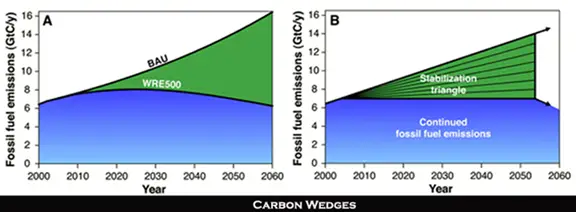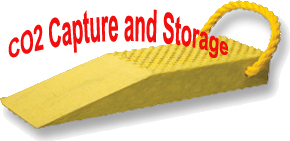The climate carbon wedge concept was introduced by two Princeton professors, Rob Socolow and Stephen Pacala. These wedges describe a portfolio of energy technologies and choices about how we live, that when taken together form wedges against increasing carbon emissions. This is perhaps better explained by looking at the diagram below.
In figure A, you can see the line in the graph goes up against the timeline and if we continue with Business As Usual (BAU) it will keep rising. However, in figure B, and if we adopt a number of different non fossil energy technologies and make different choices (the climate carbon wedges) about how we live, then the carbon emissions can be constrained (stabilisation triangle) and the line flattens out. So we need a number of carbon neutral or low emission technology wedges to bring the line on the graph back down to a point where carbon emissions are limited.

The fact is we already have the fundamental scientific, technical, and industrial know how to solve the carbon and climate problem for the next half-century. The climate carbon wedges propose to limit atmospheric carbon dioxide to a concentration that would prevent even more damage through global warming.
The current concentration of carbon dioxide is about 375 parts per million (ppm) The goal is to stabilise carbon dioxide levels at around 500 parts ppm, or less than double the pre-industrial concentration of 280 ppm. In very rough and round figures, stabilisation at 500 ppm requires carbon emissions be held near the present level of 7 billion tons of carbon per year (GtC/year) for the next 50 years, even though we are currently on course to be more than double this.
In terms of tackling climate change, there is a very real choice here between action and delay. None of the options are a pipe dream or an unproven idea, and we must choose to change from our fossil addiction to more sustainable practices or we will destroy our planet. You can adopt the 3 Step Climate Action Plan and make a difference!
Potentially, there are about 15 of these wedges that we could introduce, and most of them could be implemented right now. Whilst there are significant costs associated with these technologies, the Stern Report makes it very clear that we can’t afford NOT to address climate change. If we don’t tackle our emissions contributing to global warming now, the cost in the future to our society will much higher.
The Wedges

3. Efficient buildings
4. Efficient base load coal plants

5. Gas baseload power for coal base load power

6. Capture CO2 at base load power plant
7. Capture CO2 at H2 plant (same link as above)
8. Capture CO2 at coal-to-synfuels plant (same link as above)

9. Nuclear power for coal power

12. Wind H2 in fuel-cell car for gasoline in hybrid
13. Biomass fuel for fossil fuel

14. Reduced deforestation, plus reforestation, afforestation and new plantations
